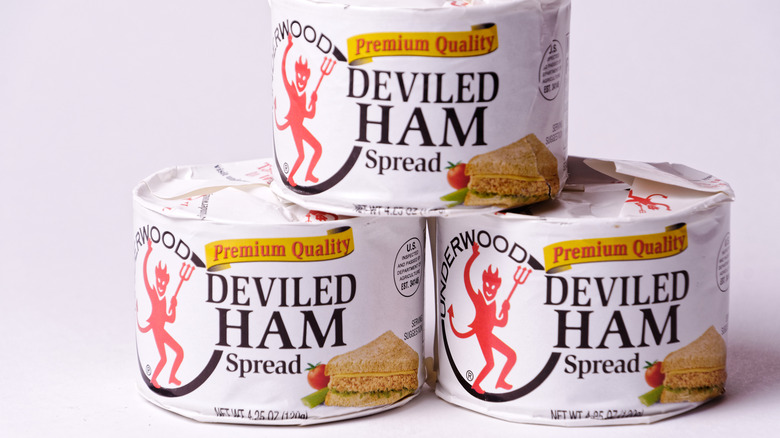The Reason A Food May Be Called 'Deviled'
Deviled eggs seem like a pretty innocuous appetizer: they're easy to make (you can whip them up in less than twenty minutes), can easily be paired with seasonal ingredients, look aesthetically pleasing without a lot of effort, and don't require many ingredients to make. All you need for deviled eggs are eggs, crème fraîche, mayonnaise, Dijon mustard, salt, cracked black pepper, and dill fronds. A standard deviled egg recipe doesn't call for hot peppers that will set your mouth on fire, so it seems bizarre that the name of the fiery red devil himself would be invoked.
Eggs are not the only food to be sinfully "deviled" in history, either. In the past, deviled ham was a well-known dish, and consisted of ground ham with hot peppers, cayenne, mustard, or other spices mixed in (via HuffPost). In food applications, the term "devil" first appeared in 1786 (per The Straight Dope), but what does it even mean?
Deviled foods used to pack a flavor punch
If you're from the South, you're likely familiar with another deviled food: ham. According to Southern Living, deviled ham isn't evil either, it's simply "plain old ground-up ham packed in a round tin can with white paper wrapped around it ... [with] spices such as hot sauce, peppers, turmeric, mustard, or cayenne pepper" that are blended into the meat. The act of deviling food, according to The Straight Dope, simply means to season it highly, often with spicy ingredients, like a curry.
One of the first companies to embrace and capitalize on the trend was The William Underwood Company. Its logo is a dancing devil, and it still produces deviled ham today. Southern Living reports that during the Civil War, men on both sides of the battlefield ate these canned foods, which cemented the term "deviled" in the cultural lexicon. Smithsonian reports that in Charles Dickens' "David Copperfield," a dish is described thus,"Mr. Micawber saves a dinner party by turning undercooked mutton into a devil." The spices that were used to devil the lamb? Pepper, mustard, salt, cayenne pepper, and a mushroom ketchup — ingredients that are considered pretty tame by today's standards.

